Hokepoints: Would Bill Walsh Draft This Team?

I'm trying out a new feature of mouse-over tags so readers who don't get some of our references can get caught up. Underlined text has a tag. If the tag is a link then you've found a link. I appreciate any feedback on its deployment.
Left: Young Wolverines some of whom were recruited for power (Upchurch). Right: Power.
Chris Brown's recent article on Smart Football included a link to a 1997-vintage article by Bill Walsh (YTBW). Chris included it as a way of crediting Walsh for correctly predicting Tony Gonzalez would become a great NFL tight end. With Michigan transitioning further toward a Walsh-ian offense, I thought I'd appropriate the whole article to see how well Michigan's 2013 offensive roster matches Walsh-ian archetypes.
Before we jump in, you'll recognize a lot of what's said here from like every NFL draft report ever. Walsh's coaching tree perforated the league for years, and that meant the things he tended to look for in players became what most of the people making draft decisions were looking for. They've been repeated so often as to become memes, however I still think going back to the source can provide some insight into how Michigan's players and recruits are being evaluated.
This is all intended to help you do your own scouting when we publish things like Hello posts (lots of those coming up) and positional previews.
Quarterback
Tom Brady prototype, Tom Brady, Tom Brady with legs? --Bryan Fuller
Walsh Says: 6'3, 210. Having a strong arm isn't as important as an "inventory" of passes, although decent arm strength is a necessity:
"Arm strength is somewhat misleading. Some players can throw 80 yards, but they aren't good passers. Good passing has to do with accuracy, timing, and throwing a ball with touch so it is catchable…
"Remember, the goal of passing a ball is to make sure it is caught ... by your intended receiver."
The most important characteristic for a quarterback is intuition/instincts. He has to be able to sense the rush, make the right decision quickly and get the ball "up and gone," and handle progressions and broken plays with grace as opposed to a sense of urgency.
"The single trait that separates great quarterbacks from good quarterbacks is the ability to make the great, spontaneous decision, especially at a crucial time."
Walsh wants his quarterback to be "courageous and intensely competitive." He also wants them mobile and defines it thus:
Mobility and an ability to avoid a pass rush are crucial. Some quarterbacks use this mobility within the pocket just enough so they are able to move and pass when they "feel" a rush. But overall quickness and agility can make a remarkable difference. As an example, there were some very quick boxers in Sugar Ray Leonard's era, but he was quicker than they were and because of that he became a great champ.
Walsh's Favorite Wolverine: Tom Brady, obviously. Tate Forcier.
What to look for in a Scouting Report: High accuracy plus high YPA. "Makes things happen."
What you can learn on film: Doesn't make you nervous. Escapes from pressure then seems calm, not rushed. Sees something and reacts quickly. Receivers aren't making tough catches or breaking stride.
What could signal bust potential: First a warning on this part not to take it as "anyone who exhibits this trait will bust." What I'm saying is beware a guy ranked highly because this feature he possesses, which is a good thing to possess, may be overrated. Here it's arm strength—more an NFL problem than college since college QBs can learn systems and Navarre their way to great college careers with only one type of pass. Arm strength with no accuracy and a terrible delivery can turn into a great player if he's got an innate sense (think Stafford), but more often a coach will try to fix it and end up with a Dontrelle Willis.
How our guys compare: So far only Devin Gardner has seen substantial play against college defenses but we've gotten about a game's worth of Russell Bellomy too. Gardner's inventory has passes for finding Gallon 40 yards downfield, zips that only Dileo can get to, and even that Stafford-y thing he flipped to Dileo in the Outback Bowl. He has ideal size, and wins the mobility category over everybody not named Denard Robinson. If you give him a lane to pick up yards with his legs he will take it. And he MAKES PLAYS, those coming first to mind being where he runs around in the backfield defying sack attempts until something worthy of forward progress appears.
His weakness so far has been in that crucial "up and gone" aspect. His delivery has a long wind-up and that exacerbates a medium-to-mediocre diagnosis-reaction speed. Previous spring games when Devin looked really bad at this suggest it wasn't a few months as a receiver to blame, although that obviously didn't help. Gardner will live and die by his scrambling and ability to make linebackers freeze in coverage when he takes a step forward. He's not Tom Brady, but Gardner's package can equal a helluvah good college QB. An offseason as quarterback in a system designed to his strengths puts the ceiling high for 2013, and off the charts if there ends up being a 2014.
Russell Bellomy (right-Upchurch) in his few appearances last year—mostly the 2nd half 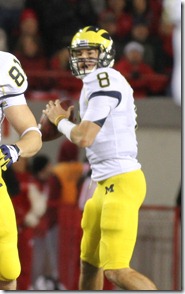 against Nebraska—gave us a fairly strong indication of his abilities. He wins Walsh points by having a catchable ball, but there it ends. His apparent lack of arm strength severely limits the inventory, his agility isn't anything special vs. Big Ten defenders, and while you can forgive a freshman thrust into starting for this, he showed a lot of panic. I am skeptical that he can contribute on this level unless his arm strength improves as much as I expect his comfort will.
against Nebraska—gave us a fairly strong indication of his abilities. He wins Walsh points by having a catchable ball, but there it ends. His apparent lack of arm strength severely limits the inventory, his agility isn't anything special vs. Big Ten defenders, and while you can forgive a freshman thrust into starting for this, he showed a lot of panic. I am skeptical that he can contribute on this level unless his arm strength improves as much as I expect his comfort will.
Shane Morris, now. Other than every scouting thing they can do with high schoolers, it's hard to say what he will turn out to be. The senior year performance and the thing that guy said in the Elite 11 about his primary read being taken away are marks against the Walsh archetype, but the size and arm and full inventory are there. He's too young to know if he will develop the rest.
Running Back
Terrance Flagler, A-Train, Toussaint –Upchurch
Walsh Says: Needs to be big enough to take punishment and always fall forward, but "some smaller runners play big." He uses James Brooks but of course we've got our own exempli gratia. The 1B for backs is again, instincts, though he emphasizes getting "the first four yards within the scheme and then rely on instincts to take it beyond that."
Walsh puts a high value on durability, which maybe isn't as important in college where the hits are lighter and the roster is deeper. The other thing he harps on is instinct, mentioning he got burned on this with Terrance Flagler. This is the difference between Michael Shaw and Mike Hart.
After that he goes into bonus features. If he can block he doesn't have to come off the field in passing situations. He has to be able to catch a screen and the further down the field he can threaten as a receiver the more "dimensional" the offense becomes.
Walsh's Favorite Wolverine: Anthony Thomas. Always falling forward, instinctual enough to be a kick returner before becoming the feature back.
What to look for in a Scouting Report: At least 185 lbs., thick and squat. Numbers don't tank against high-level competition.
What you can learn on film: Defenders look like bad tacklers (subtle movements by the RB make him tough to set up on). Falling forward, durability, operating in small spaces. Lots of D-I ticketed RBs will run sweeps all the time because their speed is just unfair against high school DEs. Watch the inside and zone running.
What could signal bust potential: Beware the big backs who wrack up huge high school yardage by running through terrible tacklers. It's hard to tell the guys who can subtly shift their bodies to make themselves difficult to bring down from the ones who just truck over a division full of future doctors and lawyers. One strong attribute can sometimes dominate a bad high school league, but D-I football requires several working together.
How our guys compare: Toussaint has shown the instincts and "plays big" at near the extreme for smallness. He looked on his way toward being a zone-style feature complement until having the unluckiest year in recent Michigan RB history. Justice Hayes is like Toussaint except he's yet to show those instincts. Dennis Norfleet has the playmaker thing down but there's a major difference in size between him and the other guys. Norfleet was listed at 5'7/161 last year, and Vincent Smith was put at 5'6/175. Hayes was 5'10/183 and Toussaint 5'10/202. Norfleet/Smith and Toussaint/Hayes are different tiers.
Among the plowshares, thick-trunked Thomas Rawls saw extensive action last year. The difference between him and Mark Ingram is Rawls seems to miss his hole a lot—that "first four yards" thing is a problem. I haven't seen enough of Drake Johnson yet to know if he brings anything different. None of the above (who are still on the roster) have yet to demonstrate they're any better than mediocre blockers.
Two incoming running backs come with the Walsh stamp of approval. Green is already 220 lbs. and his senior highlight reel shows him doing a lot of inside power running and finding his extra yards. Deveon Smith is already Toussaint-sized and seems to have that micro-instinctual quality that Hart had. No idea if either of these guys can block.
[The rest of the offense after you JUMP]
Fullback & U-Back
Tim Rathman, Aaron Shea, Joe Kerridge
Walsh Says: 6'1, 245. The NFL's limited roster meant Walsh kind of had to make his offense fit what kind of weapons he had at the hybrid blocker positions. When he had Roger Craig (think B.J. Askew) he got away with worse blocking to have a second RB in the backfield. When he had Tom Rathman (think Kevin Dudley) that worked too. Here's what he had to say on blocking types:
"This type fullback must be able to focus on a specific defender, find him and take him. It could be an inside linebacker, an outside linebacker or a defensive lineman. But he must know how to find him, know how to read what happens and make the play.
"That means he must be functionally intelligent enough to handle the variables that occur in order to be a consistent blocker."
Smart, girthy, compact, doesn't need to be very fast. However all fullbacks in this system had to be outlet receivers who get the ball clear of defenders. Here the job description starts to overlap with that of of the Michigan U-Back.
Walsh's Favorite Wolverine: Aaron Shea. Devastating blocker, effective runner, good receiver in the open field, etc. etc. etc.
What to look for in a Scouting Report: Girthy, weirdly high receiving YPC stats.
What you can learn on film: Ignore middle linebackers who stand still (high school is filled with Obi Ezehs) and see what he does against a defensive end trying to seal the corner.
What could signal bust potential: Overhyping a size-speed combination. Being able to move is secondary to knowing where to go. Massive high school running backs who obviously aren't college running backs sometimes get slotted as fullbacks because they've said they won't move to defense. Change of direction is a big deal (unless he's going to be a DE) that seems to get overlooked.
How our guys compare: The last Roger Craig-type was Stephen Hopkins but he's gone. The remainder are on a sliding scale of squat dedicated blocker to U-back tight end-ish receiver guy. Joe Kerridge and Sione Houma are the just-the-blocks-ma'am types; Kerridge was effective enough to dislodge Hopkins and hold scholarship freshman Houma to scant appearances. Hoke likes to joke that his blocking fullbacks will end their careers shorter than they arrived, and as of this writing Houma's height is not listed on the official roster.
Khalid Hill was brought in specifically for the U-spot and he even kinda looks like Kevin Dudley and Kevin Koger had a baby. Your ideal blocking fullback is 6'0/240 and your typical tight end maybe comes in at 6'4/220; Khalid Hill is 6'2/230. He looks like a big running back but his junior highlight reel is lots of catch-and-runs across the middle.
Wyatt Shallman is a different type of player. He's taller and bigger and more Shea-like. As a runner he kind of hops down the field so he can have his massive upper body hit the defense with maximum impact; that probably won't work so well against Big Ten linebackers.
Y-Tight End
Brent Jones, Ron Kramer, The Funchise --Upchurch
Walsh Says: 6'4-1/2, 245. Yes he actually is getting into half-inch increments. More so than the fullback, the "line" (as opposed to "move") tight end to Walsh should be a specialist. Type A is an extremely good blocker who can dominate a defensive end and give you a consistent running game. His receiving skills have to be serviceable enough that you're not tipping away one of your eligible receivers every time he goes in. Walsh wants him to have soft hands and be able to catch the ball while being hit by a linebacker, since he'll be operating as a dump-off option no further than their level. Give up all the speed for better blocking.
Type B is the opposite: a receiver who's big enough that you can teach him enough technique to be a serviceable blocker (otherwise just bring in a receiver and spread the field). On the non-receiver part of the job:
"Now when you get to blocking with this person it will be all technique. He is going to have to develop those techniques that he can use with reasonable effectiveness against defensive linemen and linebackers. His ability to absorb and learn technique is critical because he is not going to be able to play mass against mass."
There's a Type C: a guy who can be all of those things (insert Tony Gonzalez prediction). An A+ receiver/A+ blocker would be sweet, but not having that Walsh seems to prefer a guy who's an A+ in one aspect and a C in another to a guy who gets all B's.
Walsh's Favorite Wolverine: Ron Kramer's your first Type C. Jim Mandich is another. Great Type B's would be Joppru, Tuman, Clancy if you're into that sort of thing, Riemersma. Type A's are Mark Campbell, Eric Kattus, Derrick Walker, Martell Webb.
What to look for in a Scouting Report: In a blocker, good receiving stats; in a receiving type "coachability."
What you can learn on film: Can he catch the ball and take a hit? Tight ends are more likely than other guys to be getting those quick outlet passes where a linebacker arrives at the same time as the ball.
What could signal bust potential: The polymaths seem to do worse than their rankings here. Coaches will have patience with an outstanding receiver who needs time to learn blocking technique, or devastating blockers who need to develop their receiving skills. Not so much with a kid who is just okay at both. On the other hand the masters of one craft who cannot become proficient in the other also bust out.
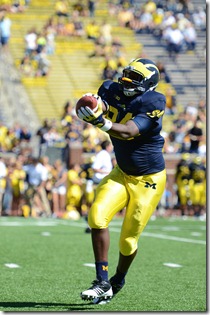 How our guys compare: Walsh would enjoy these weapons. I'm going to ignore Paskorz because he's a converted DE who was passed by two freshmen last year and start with our Type A.J. Williams (pictured at right by Bryan Fuller catching a pass I don't remember). Guys his size usually play offensive tackle and that's where scouts had him ticketed, but Michigan for now has plenty of linemen and just one real blocking type tight end on the roster. In his debut season at this A.J. was disappointing. Here's one example of many biffed blocks chosen because you get to watch some Denard & Stuff after. He did well against slower guys and when doubling, but the agile DEs spun around his blocks; he probably could have used a redshirt to work on technique before being responsible for the edge. He was rarely targeted as a receiver—Michigan kind of telegraphed its intentions when Williams was in.
How our guys compare: Walsh would enjoy these weapons. I'm going to ignore Paskorz because he's a converted DE who was passed by two freshmen last year and start with our Type A.J. Williams (pictured at right by Bryan Fuller catching a pass I don't remember). Guys his size usually play offensive tackle and that's where scouts had him ticketed, but Michigan for now has plenty of linemen and just one real blocking type tight end on the roster. In his debut season at this A.J. was disappointing. Here's one example of many biffed blocks chosen because you get to watch some Denard & Stuff after. He did well against slower guys and when doubling, but the agile DEs spun around his blocks; he probably could have used a redshirt to work on technique before being responsible for the edge. He was rarely targeted as a receiver—Michigan kind of telegraphed its intentions when Williams was in.
The other side of that coin was Funchess and he impressed enough at the thing he's a natural at to chart as a blocker with a lot to learn. He's got the A+ receiver part down; he needs to get that D-minus in blocking up a few grades. Magnus and the one coach who tells me stuff both say he's among the team's all-stars in work ethic and coachability, which suggests he's got a ceiling above the Tim Massaquoi line. Another 10 lbs. of muscle over the next two or three years gets him to the Walsh ideal.
The guy with Type C potential is incoming freshman Jake Butt. He's already 6'6-235 and enrolled early so we'll see in Spring ball if he can seize either or both roles from the sophomores. He probably leans toward Funchess's extreme and made his high school career by being a matchup nightmare—way bigger than a defensive back and way more athletic than the linebackers they could put on him. That all said I wouldn't expect him to be a Kramer right away. The ceiling for this year is probably B receiver/C blocker.
Receivers
Rice, Carter, Gallon (Upchurch|MGoBlog)
Walsh Says: 6'3, 210. That was big then and big now. This is a position you're more born into than any other. Most plays a receiver is involved in have the outcome decided by a matter of inches. If you can consistently get higher than the guy defending you, you're unstoppable. College receivers are an even greater mismatch because you kind of get to pick your matchup if you're the offense and few teams have one, let two defensive backs who can match up with an elite receiver.
That said, the first thing Walsh looks for is agility and body control—the great receivers are great mid-air contortionists. Just under that is strength—that was Roundtree's problem. The great ones also have supreme focus. "Running routes well" is a byword everyone picked up from Walsh but he doesn't mention it here—rather he talks about how receivers need to be in peak physical form. They need full-stride speed—if they get ahead of a guy they can't get caught or else the quarterback will start shorting the ball and the defense has a better shot at it. Jerry Rice wasn't the fastest guy but he wouldn't get caught once he reached his stride. Route running, it seems, is a subtlety picked up over time in an offense, not an innate ability.
Walsh almost makes a big deal about conditioning and durability—a receiver who's slowed or hurt or stiff or gasping for air gives up that all-important inch he operates in. That's a bigger deal in the NFL because teams only carry like five receivers; college teams can rotate up to seven, often have nine or so on scholarship, and always have like six walk-ons standing by just in case.
Walsh's Favorite Wolverine: Pick a #1. I went with Carter over Edwards because Anthony was the more innately talented and had that focus that Bill Walshes crave.
What to look for in a Scouting Report: Size, 40 time, vertical…here's a spot where you can actually care about the metrics scouting services can get their hands on.
What you can learn on film: Ignore the wide open stuff and see what happens when he's up against a defender. That body control is the key.
What could signal bust potential: Specialists. It seems counter-intuitive but the "possession" receivers are notorious for never managing to extend many possessions. Oh and spindly guys do well in offenses made to get them open in space but fare poorly on contested throws, which is most throws. The talent scouts tend to get this position right most of the time.
How our guys compare: Jeremy Gallon can make any molecule in his body twitch to a new position so fast it has to be measured in space-time. Unfortunately he only possesses three atoms and a couple of neutrinos, however because of the gravity field created by his near-light-speed movements, Jeremy Gallon is secretly 8 feet tall. Both of last year's freshmen (Darboh is a sophomore, Chesson a RS frosh) are pretty tall and pretty strong and pretty fast; coaches say they both still need to work on blocking. With apologies to Fred Jackson, I'm not a fan of Jeremy Jackson, who is tall but doesn't have great focus, isn't very athletic, and certainly isn't any kind of fast. The incoming freshmen are tall, not super-athletic. The coaches have struck out with some top targets for various reasons, and the kids they're bringing in this year are going to stretch Brian's YMRMFSPA creativity.
Center
Dwight Stephenson, David Molk and Protégé by Heiko|MGoBlog
Walsh Says: 6'2, 290. And thank you Bill Walsh for providing some clarity to an ongoing argument among Michigan fans as to why certain guys among the last two OL hauls are ticketed for center and others wasted there. The center is supposed to be smart enough to call the blocking assignments for the line—though a guard sometimes does that. Here's the money part:
"Centers don't often have to block one-on-one with the nose tackle, but if they can it is a great advantage. You typically slide a lineman or find a way to help the center. Or he finds a way to help someone else. Now if you have a center who can isolate one-on-one with a nose tackle, it takes tremendous pressure off your guards and everyone else."
He likes a shorter center with girth because the center needs to operate through small spaces and if he loses leverage the whole offence crinkles. "You need a center who is so quick that he can move in between people. Shorter guys can do that better than taller, rangy guys."
Walsh's Favorite Wolverine: He'd take Molk for the way he treats reporters alone.
What to look for in a Scouting Report: Academics (!), football intelligence, speed and agility, compact.
What you can learn on film: Reach and combo blocks, turning back to wall off backside pursuit, covering for other guys' mistakes, upended DTs.
What could signal bust potential: A plowhorse. Some "big uglies" make it as good centers, however the odd David Baas is more rare than the misapplied Graham Pocic.
How our guys compare: The center gets help, and that's a pretty good explanation for why Mealer not Barnum ended up there last year. This year the candidates are a redshirt sophomore with Molk comparisons, a true freshman who's a coach's kid, and maybe one of the guards getting involved.
Let's start with Jack Miller, who's of a height with Molk. You don't really get to have another guy like one of the greatest Michigan centers ever, but Miller's profile reads the same way: tough as nails, competitive, athletic, smart, kinda small. Rodriguez was fine rolling with an undersized redshirt freshman but Hoke apparently wasn't last year. That's the explanation I'm going with anyhow. Miller fits the profile if he's gotten strong enough. Not being even a whisper during last year's offensive line debacle is a black mark against him.
If it's not Miller it's…well let's imagine Joe Burzynski moves here. The onetime walk-on got some play last year at guard and would be another Mealer-like option: a guy with experience in this offense who would benefit from having help on most plays. His size was a problem last year when he was the backup guard, but that should be less so at center.
If not those guys, Patrick Kugler arrives. True freshmen almost never play at OL, and haven't except that one guy. If one can, maybe it's the son of the Pittsburgh Steelers' offensive line coach. With new starters at the guard positions as well I really don't like the idea of Kugler here yet. At 6'5/280 he's a bigger option, though that's still a long way from the kind of strength it requires to hold off a Big Ten nose tackle on your own.
Guards
Wanted: facial hair. John Ayers, Steve Hutchinson, Kyle Kalis (John T. Greilick|DetNews)
Walsh Says: 6'3, 300. And here's the key position for your offense:
"Typically, you style your offense in relation to who you have at the guard positions. You have to adapt your style to your guards."
Word, Bill. --every Michigan fan since 2008. The great guards have quickness, agility, explosion and size. They can pull, trap, or crumple any manner of defender. He can be a weaker pass blocker than the tackles so long as he's strong enough to not get knocked back—the mass of bodies protects him here. Walsh doesn't care about how much he benches; he looks for a guy who can stand his ground and checks that part off. He mentions Guy McIntyre was a guy too small for the spot despite being pretty athletic while Ayers lacked that athleticism but sufficed. This is why I moved Burzynski.
Small and agile guards can survive—Nebraska's Spencer Long at 6'4/305 is probably the best guard in the conference this year and I'd take Northwestern's Brian Mulroe, 6'4/295, over any of the monsters at Wisconsin and Ohio State. Walsh judges guards by the precision of their footwork, but really he wants to know what each guy's forte is among the myriad things a guard has to do.
That's because once a guard hits that minimum size/strength threshold to not be a liability in pass pro everything else is about executing many different and complicated types of blocks. They have to be able to time a pull right but still make it through the hole, they have to be able to come inside out to pick up linebacker blitzes, and get from Point A to Point B. Finding a master of all these techniques in the NFL is next to impossible, which is defined as finding the perfect guard in college. So Walsh believes offenses ought to start with the kinds of guards they've got and what those guards are best at, then build the offense from there.
Walsh's Favorite Wolverine: Steve Hutchinson is the nearest it comes to guard perfection—scouts thought he was a little too slow.
What to look for in a Scouting Report: Check his size and move on.
What you can learn on film: You found film on a guard? Really? Okay what's he doing? Are these highlights of him trapping, or pulling, or bowling dudes over, or going downfield like a wrecking ball on screens?
What could signal bust potential: Small and agile. Agility is a big deal, especially with the feet, however they have to get big enough to not buckle, and there's plenty of agile guards who never develop the innate awareness of what's going on around them, where to get to, and when's the right time to arrive.
How our guys compare: Okay so we fucked that one up. Patrick Omameh was a devastating 2nd level blocker who couldn't pull. Ricky Barnum if you go back is an effective combo blocker especially if you set his block up for him first, but when tasked with setting the table for Mealer…oh hell these complaints are so 2012. In 2013 we don't have any clue what they can do because they're all kiddies.
The not-kiddy option is Chris Bryant, who passes the "reacts well with gravity" test and we don't yet know much more. Insiders said he was on track to compete for a starting job last year, but they still won't say a word about his boo-boo. My own rule for rehabilitations is no news is bad news. If he's practicing come Spring ball, Bryant has to be the prohibitive favorite for one of the guard spots.
The top kiddy is redshirt freshman Kyle Kalis, who arrived nearly college ready last year and I think the coaches really wrestled whether to burn his shirt. Unfortunately for 2012 and possibly very fortunately for 2016 he did redshirt. As a recruit he was an offensive tackle just because he could hate the most donkeys that way, but he's guard size, guard length, and other than his size his footwork gets the most praise.
Among the other freshmen, Bars is a project recruit progressing ahead of schedule, and 2013 recruit Kyle Bosch is enrolling early. Dawson is another guy like Kalis but still kind of raw, and I expect he and Samuelson will redshirt. They're all really big—I can't say more until I see any of them in action.
Tackles
Steve Wallace, Jake Long, Lewan (Upchurch|MGoBlog)
Walsh Says: 6'4, 310. And here's where you need to adjust for inflation. To whit, here's Magnus when Kalis committed:
"He's 6'5". The last time Michigan had a 6'5" starting tackle was Steve Schilling, who was a poor fit so he moved to guard for his final two seasons. Before that it was Rueben Riley, who was clearly only playing tackle in 2006 because Alex Mitchell was an all-time fatty. So the last legitimate 6'5" offensive tackle (i.e. one who wasn't playing awkwardly out of position) was Adam Stenavich in 2005, who was an All-Big Ten player."
Go around the conference and there's plenty of 6'5 tackles who do just fine—Ricky Wagner, Tyler Moore and Jeremiah Sirles are all 6'6—but still, Walsh's 6'4,310 is a 1997 anachronism, not a wish for shorter than average bookends. On the other hand he doesn't give as many damns about the weight:
Of course, you could have great ones at 330 pounds, but the reality is they play well in spite of being 330. The only value of 330 is they attract the TV cameras. Some of them are not going to be 300, they are always going to be 330 or whatever. But others could be a finely tuned, highly conditioned athlete at 300, but they play at 330 and can still play.
In a tackle Walsh wants—No. 1—foot agility in a two-yard square, foot speed to a tackle is what arm strength is to the guy whose blindside he's protecting: an innate ability that can be covered but will ultimately determine the player's ceiling. The next thing is length (here's where height comes into play) of the arms and, more importantly, how well he times his extension. "The tackle must have a knack at feeling of knowing where to intersect people."
There's also an attitude for this position, which features a lot of one-on-one battles throughout the game where one loss can spell disaster—one mistake cascading into two could be the entire margin of the game.
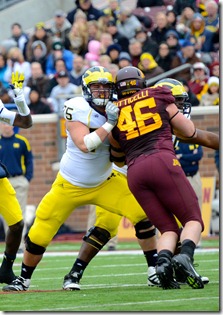 Walsh's Favorite Wolverine: Jake Long. When he was first recruited, Long was a come-lately to football but had boom potential due to his quick feet and huge frame.
Walsh's Favorite Wolverine: Jake Long. When he was first recruited, Long was a come-lately to football but had boom potential due to his quick feet and huge frame.
What to look for in a Scouting Report: Height. Maybe someone saying something about how his footwork and athleticism is incredible. "Nastiness" was a thing for a time but once scouts realized people took that as something to get excited about when it really means "he's mean to the guys he's blocking" it stopped being useful.
What you can learn on film: Watch his feet. Here's an example of really good footwork in a college OT.
What could signal bust potential: Big haws. People see a 6'8/340 17-year-old and go nuts. Remember it's an athletic 6'8/340 17-year-old you need.
How our guys compare: Taylor Lewan needs only to finish this year as the No. 1 draft pick to equal the career of Long. Michael Schofield (right: Bryan Fuller) isn't as strong as Lewan but he's nearly as agile; he can also play guard with those feet and did quite well there in 2011, however Schofield is 6'7 and "was pretty good" in the Big Ten last year at OT equals someone you don't move unless you really really want to.
That's the seniors. Let's look at the juniors.
Okay, let's look at the sophomores.
Freshmen then. Magnuson came with the fancy footwork hype but needed to put on more weight, and Braden is a huge dude who was getting the coaching buzz as being ready to play. One answer to the guard spot is if one of these guys is really ready to be the Next-Next Jake Long, Schofield can move back inside.
Of the 2013 freshmen, neither is likely to be in the mix. Logan Tuley-Tillman is a big kid who needs to work on his technique, and Chris Fox is another kind of come-lately with quick feet.
February 26th, 2013 at 8:51 AM ^
Long and Lewan look like identical twins in those photos...
September 2nd, 2014 at 11:42 PM ^
I have found many useful things out of this blog. I’d love to visit it every once in a while. Thanks!
February 26th, 2013 at 9:01 AM ^
February 26th, 2013 at 2:16 PM ^
February 26th, 2013 at 9:01 AM ^
February 26th, 2013 at 9:07 AM ^
Thanks Seth
February 26th, 2013 at 8:44 PM ^
February 26th, 2013 at 9:19 AM ^
The mouse over tags are a good idea to help new readers keep up with some of the references. Be careful though, sometimes the old adage of "if you have to explain it, the joke isn't funny anymore" becomes true. That said, I think they were well used in this article.
February 26th, 2013 at 9:20 AM ^
The mouse-over tags are nice, but is there a way to format them so that they don't disappear until you "mouse away" from them? Right now, you mouse over and have about 5 seconds before the tag disappears.
February 26th, 2013 at 12:54 PM ^
I think that's a browser setting. Mine don't disappear until I move my cursor off them.
February 26th, 2013 at 9:22 AM ^
Did you mean "proliferated"?
February 26th, 2013 at 10:27 AM ^
I actually think he meant to use "permeated" there.
February 26th, 2013 at 10:52 AM ^
No, clearly he just was trying to use permacultured
February 26th, 2013 at 3:14 PM ^
Damn you people. I thought "perforated" was clever, since it means the thing you think it means and literally means "poked holes in" -- which is a great way to describe what the WCO did to the NFL.
February 26th, 2013 at 4:02 PM ^
It was clever.
February 26th, 2013 at 6:37 PM ^
Usually I just assume Seth has thought more moves ahead and attempt to figure it out. The internet and "search" are useful for this.
February 27th, 2013 at 12:10 PM ^
The only thing that has been perforated lately is your artsy-fartsy writing style, and I would rather listen to reruns of the Dan Dakich show on 1070 the fan than read your articles.
February 27th, 2013 at 4:30 PM ^
Funny. Fuuuunnnny.
February 26th, 2013 at 11:44 AM ^
Glad I'm not the only one who caught that one. Now I don't have to go find the "I do not think it means what you think it means" jpeg.
February 26th, 2013 at 9:27 AM ^
Damn informative. I like it.
February 26th, 2013 at 9:33 AM ^
...Good effort!
But srsly [roll over tag text: useless abbreviation of seriously] folks, this is the kind of front page content that Seth [roll over tag text: MGoAuthor, Asst Editor, Moderator formerly known as MGoUser misopogon] is great at. Analogizing Michigan's roster to Bill Walsh archetypes is brilliant given the stated desire of Hoke/Borges to create a Great Lakes Coast offense [roll over tag text: weak attempt to create an MGoMeme for Michigan's offense based on Walsh's West Coast offense with a nod to Borges' Auburn Gulf Coast offense].
February 26th, 2013 at 10:22 AM ^
I like it when you grace us with your presence
February 26th, 2013 at 10:26 AM ^
Dude, Third Coast Offense [roll over tag text: the Great Lakes are sometimes referred to as the Third Coast, as in Bell's "Third Coast Ale"]
February 26th, 2013 at 9:33 AM ^
This is a really good article, very well written, detailed and informative. I feel like I'll return to it in the coming years for reference, thanks Seth!
February 26th, 2013 at 9:42 AM ^
This is too conceptual for me. I do not understand the references.
February 26th, 2013 at 9:44 AM ^
I was a commenter on that post, yeah that post. I would like to say a wise man takes the negatives along with the positives and learns to be a better person in which ever way it involves that person.
Im sure Seth had hurt feelings because he's human but I would like to tip my hat to him for walking away from it with an open mind and trying to become the best Seth can be without losing himself.
February 26th, 2013 at 9:53 AM ^
I am now a more informed consumer of football. Great job.
February 26th, 2013 at 9:59 AM ^
Good article but I want to make a comment on insisting on playing a particular style. The NFL is a copycat league. Once a particular style gets popular for example Walsh style West Coast offense every team will compete for the same limited group of players. The cap guarantees you will be unable to spend your way to success. A good example in my opininon was the sudden popularity of 3-4 defenses after NE had success. All of a sudden there was competition on the draft and in FA and it became much harder for NE to sustain a great defense.
On offense I believe flexability and a willingnes to change is much more important then a style. Again looking at the best in NE, the offense seems to be remade every year. They go from a feature NFL back(Dillon) to a feature receiver(Moss), to spread & shred with role players, two spread with two TE's.
The one advantage of college is unlike the NFL all teams are not treated equal. The brand teams can recruit as many great players as they have scholarships and the SEC teams more. In college if you are picking the best players of a type you will at least have success against your little brothers on talent alone. Whether your finished product really is better or your technique better will not become apparant until you play another team on equal footing. And of course if you have the misfortune of playing Alabama you will be the little brother and your technique and style will be irrevlevant.
February 26th, 2013 at 10:26 AM ^
Would love to read one on the defense. Also, mouse-over tags are a good idea. Would of helped me out a few months back when I had no clue what anyone was talking about.
[edit:] WTF is up with Steve Wallace's helmet?!
February 26th, 2013 at 10:30 AM ^
I think that's one of those old-school anti-concussion caps like Steve Tasker (I think) wore as well. That's what it looks like, anyway.
February 26th, 2013 at 11:27 AM ^
From his Wiki page. "Throughout his career, Wallace endured many concussions, and was known for wearing a styrofoam (Procap) helmet atop his normal helmet to reduce the impact."
February 26th, 2013 at 10:02 AM ^
thanks for that comprehensive look Seth. Puts a lot into perspective.
But WOW, is Kalis a beast. Can't wait to see how he does with regular reps. Love it!
February 26th, 2013 at 10:03 AM ^
Here it's arm strength—more an NFL problem than college since college QBs can learn systems and Navarre their way to great college careers with only one type of pass.
Is this a criticism of Navarre? It looks like a criticism but I don't understand it.
I cannot abide even vague, unspecified criticism of John Navarre.
This shall not stand.
Navarre threw short, medium, and long passes well. He put better touch on halfback screen passes than anyone who followed him. After Navarre, the halfback screen was basically dropped from the playbook. He threw a fine deep out--the classic arm strength pass. He was even more consistent with his deep ball than anyone who followed him. Henne threw beautiful bombs but also tended to airmail every third one even when his reciever was all alone.
February 26th, 2013 at 11:49 AM ^
At least until his senior year, Navarre regularly threw to Tacopants on medium-range passes over the middle of the field. Gave me heart palpitations every time. He also had the nearly inexplicable habit of throwing the ball directly into the turf about once a game. He was quite good as a senior, having minimized the ocurrence of these snafus, but let's not make him into something he's not.
February 26th, 2013 at 12:09 PM ^
I don't think he's criticizing as much as making a distinction between good and great college QBs. Brady = Great. Navarre = Good. In college, good can get you by in most cases and allow a team to still be competitive at an elite level.
I think the relative trajectories of both players professional careers bears this analysis out.
February 26th, 2013 at 12:13 PM ^
I'm not sure myself, but I think it lines up with my personal criticism of Navarre, which is that his passes were predictable. It was the same motion and while the throw was quick, the setup not so much. An NFL-caliber QB can do all sorts of tricky things -- throw blind to a spot, hit a receiver in stride, throw on the run, lob it, flick it, sidearm it, pitch it. It messes up the defenders' timing and allows for greater variation in routes. Navarre had a pretty throwing motion, but it was only one throwing motion. I got frustrated watching him because he was so easy to read -- he'd square up to his target, set his feet and zip it. Same speed, same trajectory, every time. Which is all fine and good (nice fundamentals) and it made his throws very catchable and accurate, but it means when it wasn't the ideal throw he'd have to do it anyway and sometimes the DB got a jump on the ball. It put a lot of pressure on the receivers to create their own separation. While I agree that he's better than many of the more recent Michigan QBs, I don't think they dropped the halfback screen because he was uniquely qualified to do it; Navarre needed the halfback screen to be there because he sure as hell wasn't going to improvise his way out of trouble. It was the best way to use his talent without overexposing his flaw. I don't remember toooo many INTs but I remember more than a few critical PBUs with the game on the line, though I'll be the first to admit my memory's fuzzy.
Henne was just as bad, except worse. He would lock into a target so bad you could hear a computerized "beep beep beep" going off in his head. Sure he could zip it but if you give the DB a half second to read the QB and know exactly where the ball's going to go, and then throw it without Navarre's accuracy. . . argh. Mgoblog liked his progression but even as a senior, Henne was teasing my inner cornerback like crazy. He put even more pressure on the wideouts to create separation than Navarre did. If he didn't have Braylon Edwards, Jason Avant and Steve Breaston to throw to, his career would've been a LOT worse. That said, having NFL-caliber receivers and a QB who could zip it to them was a successful formula.
February 26th, 2013 at 12:40 PM ^
February 26th, 2013 at 1:02 PM ^
Thanks for the reply. And please don't take this as confrontational but I think that Henne's problem was that he lacked the touch for screen passes. The bit about height differential and short running backs sounds completely made up and not something I've ever heard before.
If short running backs have issues with screen passes then why are 3rd down backs traditionally smaller quick guys when they are the main recipients of screens? Off the top of my head I can think of Darren Sproles and Ray Rice, both prolific screen catchers, are both also short. Those are just the first two I thought of. I could go on and on.
But my main point, and it is mostly schtick, is that John Navarre was a good QB and not deserving of the constant abuse he still gets. People fall all over themselves adoring Chad Henne and hating Navarre even though Navarre had a better college career. Clearly, that is just my opinion.
I also never got the impression that Denard was very good at halfback screens either. His big screen was the throwback where he was mostly just chucking the ball back to a wide open WR. Virtually no touch required.
February 27th, 2013 at 9:00 AM ^
Methinks at the NFL level, being a good target is a secondary consideration for a back. 3rd down (pretty much every NFL play, really) is literally all about whatever it takes to move the sticks, so you want to keep the defense guessing. Being short means a 3rd down back can provide lots of variation in fast-developing plays, whether it's cut-blocking a blitzer, running a tough route (rapid changes in motion like moving as if to pass block then tearing for the sideline) or literally hiding behind the offensive line. At the college level there isn't a "3rd down back" per se so I really doubt we recruit on height. I see quite a lot of height variation among Michigan backs.
Lobs may be easier when the target is taller, but what you REALLY look for in a 3rd down back are good hands; they excel at catching passes and not fumbling. The pass can be perfect and the target ideal, but the back still has to catch it and the big guys often lack upper body control. Many of them are marginal in other ways and become ball control specialists to stay employed, so that could also have something to do with it.
February 26th, 2013 at 10:05 AM ^
I've been on this blog for some many years now and feel like I am pretty savvy on all the references and jokes. Still, I find myself a little confused on occassions and the roll over text helped me. I do agree with previous poster that it would be nice if the text could stick around a little longer.
February 26th, 2013 at 10:15 AM ^
So, I got into a discussion with an ohio fan I work with over receivers. He said he read somewhere that Hoke and/or Borges said receiver speed was overrated and had a good laugh at that one. I said that it made sense to me that although speed is important, if you can't get open (through good route running) and being able to go up and get the ball, then the fastest guy isn't helping your offense. Oh, and then there's that little part about having good hands and all.
After reading Walsh's outlook towards receivers, I'm starting to think that speed is indeed not quite as important as the aforementioned skills, along with body control. Not that speed isn't important, its just one factor of many that make a good receiver. Or a great receiver. I think I recall that even one of the (arguably) greatest receivers Walsh had in Jerry Rice wasn't the fastest guy out there, but had the other skills much more than his peers.
February 26th, 2013 at 10:23 AM ^
I would love for Jason Avant to come back through the door anytime. And The Threat kind of speaks for himself. Speed is good, but not required.
February 26th, 2013 at 12:04 PM ^
The Key ingredient for Walsh was endurance, or more specifically the ability to run at top speed through the entire route and for every route run during the game. For a receiver to be a threat on each and every play, they have to run their route at top speed for the entire length of the route, so for deep threats 20-30 yards worth each play. Jerry Rice had an insane work ethic, and even other NFL players who attempted to work out with him would admit defeat. So think about running 20 yard sprints 40-60 times during a full game and maintaining the same speed such that the timing of the QB is always on target.
Woodson made most of his interceptions because he would allow the receivers to get open a little, and then had the instinct and athletic ability to close down that opening once the QB threw the ball. A receiver who runs fast in the first part of his route and then slows down creates that same kind of dangerous interception opportunity. He burns the guys he's covering, who then sprints as fast as possible to catch up, just when the receiver is slowing down because he thinks his job is over.
My summation of what Hoke wants from every player on his team is effort and precision. Athletic ability is definitely something they want to select, but you can't coach god given talent, you can't coach height and speed. You can coach precision and technique, and given a player with slightly less talent, but a highly coachable attitude and elite work ethic, Hoke will pick the work ethic every time.
I bet that Gallon has that Jerry Rice like work ethic, and the comments from Denard and Devin indicate that he is a go to guy because you can rely on him. While it's likely that Gallon will get the #21 jersey, I really think, at least for the short term, he is the only player who has the in air dexterity that reminds you of Anthony Carter, and he should be wearing the #1 jersey. But then again, I grew up on Michigan football with my dad screaming at the TV on 3rd down, "Throw it to Carter" so I'm pretty biased.
So yeah, look for speed and height, cause duh, but those god given talents can't make up for lack of effort and precision.
February 27th, 2013 at 9:14 AM ^
It's an oversimplification. I think what Walsh is against is recruiting speed at the expense of actual receiving ability. A lot of teams think if they can find that receiver that can burn the last guy, they win. South Carolina certainly made a good argument; I loved watching Kovacs but all his skill and discpline didn't matter when he couldn't keep up with his man.
But there are also busts because speed is all they have. A simple one-deep zone where any post route will be met with a hard-hitting FS in the back of the receiver is all they need to take away the deep threat. That takes pressure off the defense and now it's like the post route isn't there at all. What's the point of a decoy if it doesn't scare the defense? (As an aside, this is why I hate receivers who don't run hard on every play.)
Speed is important, but the receiver has to reliably catch the ball even if it's off-target. Then when he races upfield you can stretch the defense vertically, opening up the middle of the field. To me, the importance of a receiver isn't what he does with the ball, but how the defense accounts for him when he doesn't have the ball. What I want in a wideout is a guy who has two DBs accounting for him on every play; that puts the run defense in a very tough spot because if any play breaks past the linebackers the 5-yard runs become 20-yard runs. But to strike that sort of fear into the secondary, the receiver MUST be able to catch anything thrown near him. Beyond that, every bitter ounce of speed you can squeeze out of the guy makes him that much more dangerous.
You want receivers to be fast, blazing fast, but a fast receiver who can't catch is like a Ferrari without a steering wheel. Sure it's fast, but you're not gonna go anywhere with it.
February 26th, 2013 at 10:18 AM ^
Well, I'mma let me finish, but I just couldn't do it until I gave written expression to the wave of incredulity that washed over me when I read this:
"Walsh's Favorite Wolverine: Tom Brady, obviously. Tate Forcier."
This is not me being a smartass: I'm honestly not sure if you're being funny here. You might be able to argue with a straight face that Forcier was accurate, though Walsh's emphasis on "passes being caught ... by your intended receiver" would seem to put the lie to that. But something ol' Tater resolutely did not possess was the ability to "handle progressions and broken plays with grace as opposed to a sense of urgency", still less to escape from pressure in a manner that "seems calm, not rushed." Unless you think turning your back to the play and wheeling around 20 yards behind the line of scrimmage with the ball hanging out to the side like the proverbial loaf of bread was just a particularly idiosyncratic way to display calmness.
Again, maybe you were trying to be funny. Regardless, I'm confident that the rest of the piece is quite good. But unless you're saying that Forcier was the best West Coast prototype, like, since Chad Henne, I think you've been watching way, way too much of the spring practice 2009 "Weapon of Choice" hype video lately.
EDIT: Just returned to reading and saw this one: "Doesn't make you nervous." I'm now about 70% certain I just missed the joke.
February 26th, 2013 at 10:35 AM ^
The rest was indeed very good. Also, I realize now that the little burst of pissiness by those who carefully measure the amount of humor deployed on their favorite sports blog seems to have pervaded the comments to some degree. I don't care about that, I think the overall style of the blog is great, and this is just as well-written and informative as most of the things Seth writes. (I'm kind of with people in terms of ignoring 'Dear Diary,' but that's because of it's inherent nature as 'second-tier of the blog digest', which may be something of a flawed concept.)
February 26th, 2013 at 10:58 AM ^
Perhaps I missed a joke too, but I think you are wrong about Forcier.
1. Forcier had a very accurate arm. IIRC his accuracy and DSR numbers compared favorably to those of Henne as a freshman, and that doesn't even account for the fact that he played half the year with the same shoulder injury that forced Sam Bradford to miss an entire season, and that Henne was throwing to future NFL wide receovers and Forcier definitely wasn't.
2. You may not have liked the way he held the ball when he did so, but Forcier was extremely effective at buying time in and around the pocket while keeping his eyes downfield. I think that the ability for a QB to keep his eyes downfield and still make a good throw on the run is what is ultmatey desired when someone wishes for a QB who can handle broken plays with grace instead of a sense of urgency.
3. "Doesn't make you nervous" is totally subjective. You are obviously entitled to your own opinion, but I remember being much more nervous about something bad happening when Denard dropped back to pass on 3rd and 11, than I ever was when Tate was playing.
Ultimately, is Tate one of best former Michigan QB's for the West Coast Offense? I don't know, but I don't think its such a ridiculous assertion that it was intended to be a joke. The kid obviously had his flaws, but when his mind was in it, he still had the potential to be a very good football player.
February 26th, 2013 at 11:54 AM ^
Personally, I just pretend like Forcier didn't happen and it simplifies all analysis. We've only got that one season, where he was injured and being yanked in and out of the lineup all the time and the offense was so weird then.
If Michigans offense in 2011 was criticized for being "unsustainable" then 2009 was off the charts in that category. I don't think we will ever know if Forcier's apparent ability to flip the switch in the 4th quarter and run around like a headless chicken adlibbing to amazingly good effect was skill or insanely good luck. There is evidence on both sides.
February 26th, 2013 at 2:01 PM ^
1. Like I said, Forcier's accuracy may be something one could point to. But he threw a lot of picks. Hence the reference to the intended receiver catching the pass.
2. Forcier was relatively successful with his rollout schtick until he came up against better defenses, who proceeded to shut it down with relative ease. He absolutely did not have pocket presence - at the hint of a pass rush, he tended to immediately roll out to the side, rarely making the subtle moves that would allow him to keep his eyes downfield. Again, his preferred move to avoid the rush was to literally turn his back to the line as he rolled out. And the loaf of bread thing was not merely a pet peeve - he lost more than a few fumbles that way, IIRC even a couple of times on his own, without a defender having touched the ball.
3. Yeah, I guess nervousness, as an emotional state, is axiomatically subjective. The Denard comparison, though, is a slam-dunk straw man argument, since there is no suggestion at all that Denard would be Bill Walsh's pick over Tate. I actually implied this when I said that Seth must have picked Forcier as simply the most Walshian QB since Henne. Anyway, I still can't believe that someone could interpret Tate's play as exhibiting calmness in the face of duress, but hey, maybe I'm in the minority there.
Here's a sampling of stats against decent defenses in 2009 (note that the inclusion of Notre Dame and Illinois are rather generous.) To my mind, they don't demonstrate much Walshian mojo at all. Now you might say that, indeed, Forcier was but a freshman that year. Great - but that's the only real year we've got. So maybe the mythical, clear-headed and experienced Senior Forcier looks like Joe Montana - but that is a figment of the imagination and nothing more.
February 26th, 2013 at 2:31 PM ^
It was kind of a joke and totally serious. The effect I was going for was exactly the "What What What" Mrs. Broflovski you gave me.
Forcier was exactly what you look for in a perfect WCO quarterback. He throws a very catchable ball accurately whether on the run or stationary (preferably on the run) but more importantly he had that cocksurity and innance presence to make a play out of something.
He took apart some good defenses, in fact he was the secret reason the 2010 was so good. He was also a freshman for his starting career, and he exacerbated his freshman-ity by never watching film or studying the playbook or doing all the things that Brady/Montana/Favre did like madmen to get to where they are. As per Three & Out, Denard winning the job in Spring 2010 was basically Denard going from freshman who didn't study to sophomore who studied the normal amount, while Forcier was out fuckdaddling his way out of football.
Acting purely with intuition (because lord knows it wasn't hard work), Forcier as a true freshman was nearly as effective a passer as Henne as a junior. Think back to Henne as a freshman, and how reigned in he had to be to avoid making mistakes. With Forcier there was no holding him back--you rolled with it and sometimes you got true freshman and sometimes you got true greatness. You can beat Notre Dame on moxie alone, but nobody's ever beaten Ohio State without working his ass off, and Tate's two awful outings against OSU stand as a testament to what happens to those who don't respect either the game, or The Game.
All that running around like a chicken was because he wasn't willing to do what it takes to translate his innate abilities into a great quarterback. But I don't think it's even a question whether those innate abilities were there.


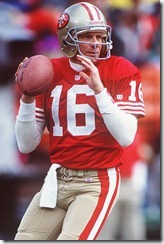

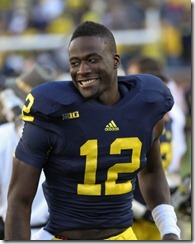
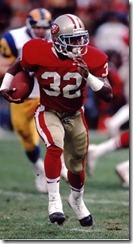
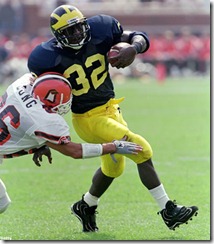
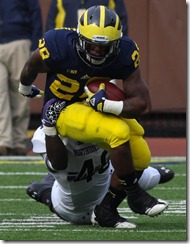
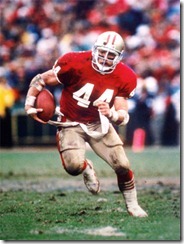

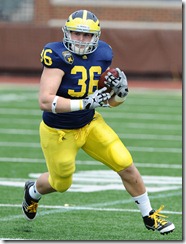
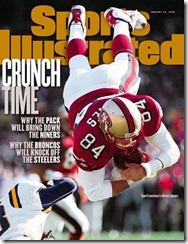


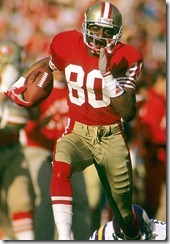
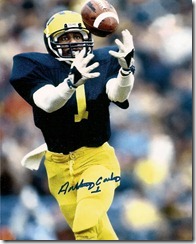
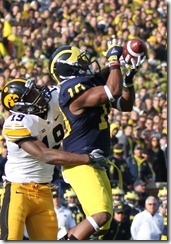
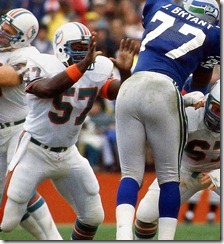
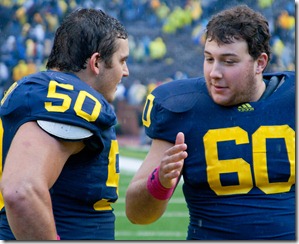
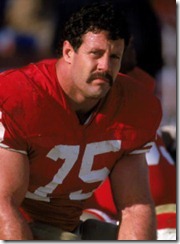
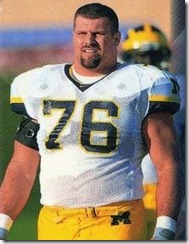

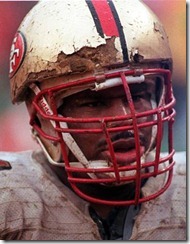
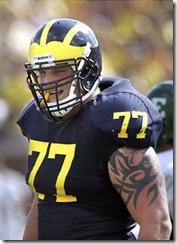



Comments